17 July, 2001
Tuesday
Woke this morning to the first real rain Iíve seen since arriving here more
than 6 weeks ago. As luck would have it I planned to go out with Anne
Jensen and her archeological group to Point Barrow where she is presently
mapping and digging an exploratory site. The Point, as it is now called,
was the site of a native village, Nuvuk. This Inupiat village consisted of
300 to 500 inhabitants and was inhabited up to approximately the 1930ís.
Before that time there are stories of the village being located farther out
on The Point. The Point might have extended out as much as 1 to 2 miles
more than what exists today but erosion claimed the land forcing the
villagers to relocate to the site Anne is now exploring. Eventually with
the increasing services Barrow offered and the building of the school here
in the 40ís and 50ís, families started moving the 10 miles south from Nuvuk
into Barrow and eventually Nuvuk became deserted.
The Point, as pictured in a previous journal entry, now consists of a
narrow spit of gravel and sand, which extends out into the ocean and around
Elson Lagoon. It has become a place to drive your ATVís and is a must for
the tourists on the Tundra Tour excursions. The locals also duck hunt in
the area during the summer. A pile of whalebones and scrap meat lies here
to keep the bears out of town. Half way out to The Point there are a
number of fenced, marked graves testifying to the existence of the village,
which was once here. Over the years the sites have been ransacked and
little remains of the once thriving village. Artifact hunting is strictly
forbidden but in a place that is as isolated as this many areas have been
disturbed and it remains an on going problem.
There are local stories and memories of this location as a small village
whose Inupiat population lived and hunted here for hundreds of years.
Anne, who has lived here for 5 years plus worked in the area for 10 years
previously has researched the Point and is familiar with its history. Two
years ago she excavated here, uncovering many artifacts consisting
mainly of various hunting implements.
Anne is working with Claire Alix, an anthropologist from France and Dave
and Ian Pulman, a father and son team from Maine. Dave is also an
archeologist who lived in Barrow a few years ago. When here, he did a
preliminary mapping of the historic village. Anne and he are remapping the
area to get a clearer more precise picture of the site and the specific
locations of possible places to dig.
The one house site we are excavating, pictured below, is on the cliff edge,
exposed to the ocean. There were/are many more houses at this site but the
ocean has claimed them and that is the continuing situation now. The one
house they are conducting the exploratory dig on might not last over the
next year or so depending on the storms which wash away the sand and gravel
landscape the Point consists of. It is a race against the elements. This
is occurring in town also. The sea is claiming another old village site
that lies with in the town of Barrow.
The traditional houses were constructed of sod and whalebones. A shallow
pit was dug into the ground, whalebones were used as roof supports and the
structure was covered with sod. Houses had a rounded shape and were heated
and lit with whale oil. From all accounts they were warm and protected the
Inupiats from the long, harsh winters.
There is not a lot of archeological work being conducted in the Arctic and
I asked Anne why. If people know these sites are here why aren't they
being protected and excavated to preserve the artifacts? The main reason
seems to be money. Doing archeological work in the arctic is very
expensive. The sites are usually remote so travel is expensive. The
environmental conditions are harsh so provisions have to be made for food
and lodging that are difficult. The artifacts which are found present a
money sink also because they are usually made from materials, which have to
be specially dealt with, and ongoing care has to taken in preserving them.
Bone, ivory (tusks), antler, wood and skins or hides have to be cared for
and many museums and/or Heritage Centers do not have the facilities or
endowments for such projects.
We arrived at the site by ATV's and Anne and Dave started surveying, which
kept them busy the entire day. Claire, Ian and I worked at the house site.
They had previously laid out 4 squares and were slowly scraping the top 1
to 2-cm. layers into dustpans with a small trowel carefully looking at the
sediments. We did this all day. Each of us found various artifacts.
This is good because as long as you can find things it keeps you excited
and motivated! Any organic material that was found had to be white
bagged, mostly wood pieces and pieces of whalebone. When an artifact was
found it had to be placed in a separate bag, marked where it was found
within the square, dated and the finders name written on the bag. The
excess dirt, sand and gravel, was dumped over the cliff and not strained,
as is the case in other digs. The arctic sediment is so gravely that
sifting does not work. At the end of the day all the white bags are
brought back to the lab. The contents have to be washed, dried, marked and
catalogued. Where digging the artifacts up may take 7 hours the second
part of the job might take 3 or 4 times as long. After that Anne will have
to write a report on what was found and show the importance of the dig in
order to get funding to continue her efforts before more is lost to the
ocean. I hope her efforts are rewarded.
During the day we experienced every type of weather the arctic has to
offer, it changes that quickly up here! Rain, sun, wind, clouds, and clear
skies: all within the 7 hours we were out. Ian, a high school sophomore is
here with his archeologist dad and getting some dig time in. He was able
to answer questions and help identify things I found. Doing something like
this during the high school years takes one to places and gives one the
opportunity to meet people that you ordinarily would not meet. It was
enjoyable talking with him and hearing his thoughts about the Arctic. I
wish more high school students had experiences that took them to "outside"
places.
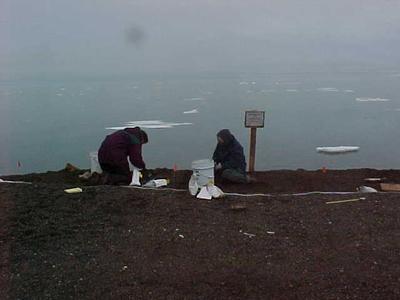
Claire and I digging at the house site. As you can see it is located literally at the end of The Point with the ocean below.
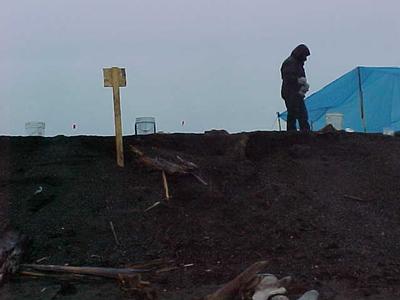
Looking up from the beach with Claire in the picture. You can see how the site has been eroded.
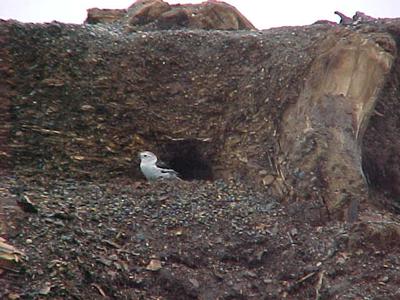
Location, location, location!! This snow bunting has built her nest about 10 centimeters below where we are digging. All day she flies in and out and is not happy with us. Hopefully by the time the nest is exposed the fledglings will have left the nest.

Ian holding one of the artifacts found . It is scuptured out of whalebone and has 4 holes drilled in it.
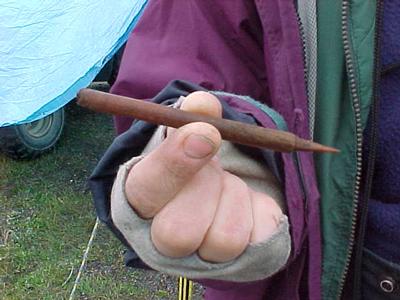
A arrow piece made out of antler.

Clair and I digging and looking through the gravel. The buckets are filled with the excess and dumped to the side of the site. Trowels and dust pans are used to sift through the sediment.
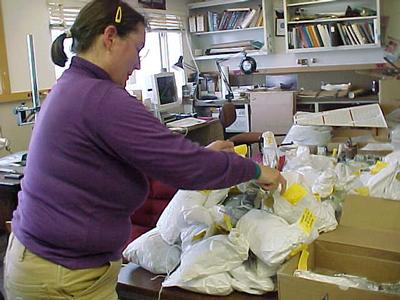
Anne in her lab stacking up the days white bags full of artifacts and other materials found at the site. The contents will have to be washed, dried, marked and catalogued in the coming weeks.

Anne in her lab examining a piece of whale bone she found. There are numerous scratches on it that look like a knife blade was used on it but for what purpose she is not sure.
Contact the TEA in the field at
.
If you cannot connect through your browser, copy the
TEA's e-mail address in the "To:" line of
your favorite e-mail package.
|
